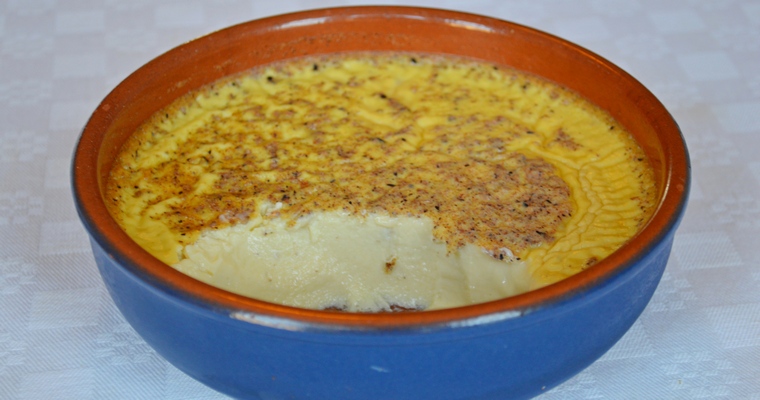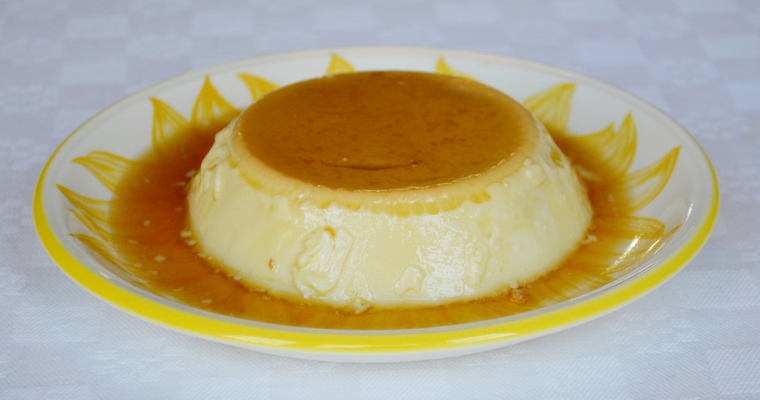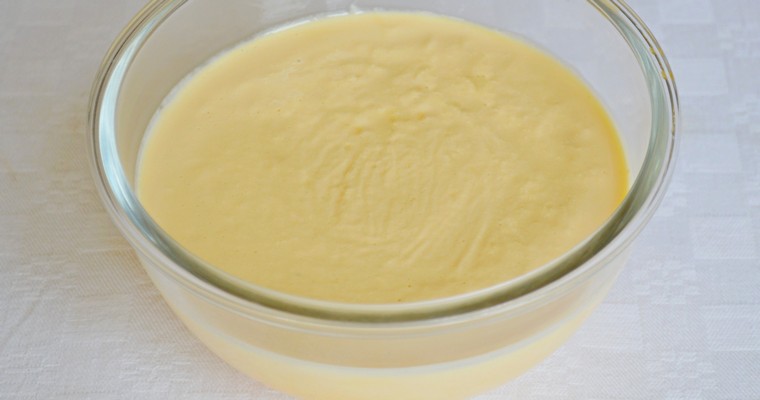Creamy, cold dessert made by pouring custard into ramekins and baking until set. This Dairy-free and Paleo recipe is made with almond milk and honey.
| Skip straight to the recipe |
01. What is baked custard?
Custard can be either fluid or set, depending on how it is cooked. Pouring custard is a sweet dessert sauce that is served over hot desserts like steamed puddings, fruit pies and fruit crumbles. It is made by whisking hot milk into egg yolks and sugar, and then heating gently in a saucepan until the sauce is thick enough to cling to the back of the stirring spoon. Baked custard is served cold as a dessert in its own right, rather than as an accompaniment. It is more solid, as the egg and milk mixture is poured into a mould and cooked in the oven until it sets to a gel-like consistency. Because the desired consistency is solid rather than fluid, the recipe includes egg whites for their gelling properties. However, too many egg whites will increase the firmness while reducing the richness and softness, so they are only added at a ratio of 1 egg white to 3 egg yolks.
02. What causes custard to set?
Reduction sauces like gravy are thickened by heating to boiling point to drive off the excess water. Egg-based sauces like custard are thickened by the proteins in the sauce rather than by evaporation. When heated, egg proteins coagulate to form a solid mass that acts as a gelling agent. You can see this principle in action when you crack an egg into a hot frying pan, or scramble eggs in a saucepan. Egg-based sauces are quite temperamental to cook, being sensitive to high temperatures. If the temperature exceeds 80°C/176°F, then the eggs overcook and scramble, resulting in a lumpy sauce that has a curdled appearance. But if the temperature does not exceed 70°C/158°F, then the egg proteins do not coagulate, resulting in a runny sauce. Making pouring custard on the stove requires patience and vigilance – it is not a thing that can be attempted while multi-tasking, as it must be stirred constantly to turn over the bits that sit over direct heat.
03. Why is baked custard cooked in a water bath?
The danger of curdling is solved by cooking custard in a water bath. This simple technique involves pouring the custard into a dish, and then sitting the dish in a deep roasting tray half-filled with water. As the temperature of the surrounding water cannot exceed 100°C/212°F, the custard is insulated from direct heat. However, custard continues to cook for several minutes even after it is removed from the heat source. This is called carryover cooking, and refers to the fact that the residual heat from the exterior of hot food will travel to the cooler interior until an equilibrium of temperature is reached. This heat transfer exchange explain why pretty much all food benefits from resting, and not just meat.
04. How do I prevent baked custard from overcooking and weeping?
While cooking times provide a useful estimate, they should not be slavishly obeyed. Instead, check for doneness by removing from the oven and giving the dish a gentle shake – if there is a slight wobble in the middle of an otherwise solid mass then it is done. Remember, the centre will continue to cook as it cools, due to carryover cooking. If you wait until the middle is fully firm before removing from the oven, then the centre will overcook as it cools. Overcooked baked custards ‘weep’ a clear liquid that collects at the bottom of the dish. This happens because the egg proteins have bonded together too tightly, squeezing out the water molecules.
05. Can you make dairy-free baked custard using nut milks?
Nut ‘milks’ are an emulsion of ground nuts and water. They are made by grinding nuts to a paste and mixing vigorously with water until fully blended. The mixture is then strained through a fine mesh material. Just like egg-thickened sauces, nut milks do not respond well to high temperatures. If you heat nut milks all the way to boiling point, the heat-sensitive emulsion breaks down. This causes the finely ground nut particles to separate out from the water, resulting in a grainy texture. As egg-thickened custard should not be cooked to a high temperature, this makes nut milk a perfectly acceptable substitute for cow’s milk.
06. Which is the best nut milk to use in custard?
At its heart, baked custard is nursery-style comfort food. The slippery texture and delicate flavour signals blandness, and yet this unprepossessing dish has a luxuriously rich and creamy mouthfeel. It is the one dish I crave when I am ill. I’m not sure how much of this is because it is easy to swallow and digest, and how much is due to the fact that my mother always fed it to her little invalids! My point is that distinctive flavours have no place in a baked custard. Coconut, pecan and hazelnut milks produce sweet-tasting nut milks, while walnuts and brazil nuts produce bitter-tasting milks. The best nuts to use for baked custard are those that produce mild-tasting, buttery milks, such as almonds, cashew and macadamias. Out of this selection, almond milk produces the best baked custard.
07. How can I use up the leftover egg whites?
Egg whites are used in cooking for their aerating and binding properties. They are comprised of 90% water and 10% protein. When whisked, the protein molecules trap air, which causes the volume to increase by up to eight times. This transforms the egg whites from a slimy, transparent gel to a light, white foam. When heated, the protein molecules bond together to create a strong matrix. Egg whites are therefore used primarily to create a light and fluffy crumb, or to stop dense ingredients from falling apart and crumbling.
Recipes for using up the leftover egg whites:
Tips & Tricks
- do not boil the almond milk – nut milks separate and become grainy when overheated
- remove from the oven while the middle still has a slight wobble – the centre will continue to set as it cools due to carryover cooking
Ingredients
- 600ml almond milk
- 1 vanilla pod (or 1/2 teaspoon vanilla extract)
- 4 egg yolks, plus 2 whole eggs
- 3-4 tablespoons honey (to taste)
- 1 whole nutmeg, for grating
Instructions
- Preheat the oven to 150°C/300°F.
- Pour the milk into a saucepan. Slit the vanilla pod in half length ways. Scrape out the seeds with the tip of the knife and add to the milk, along with the pod. Heat slowly over a gentle heat to just below boiling point, until you see small bubbles barely breaking the surface. Expect this to take at least 10 minutes, and stir frequently with a whisk or wooden spoon. Take off the heat. Fish out and discard the vanilla pod.
- Whisk the eggs and honey until fully blended. Gradually pour the hot milk over the eggs in a thin stream, whisking constantly to prevent the hot milk from curdling the eggs. Keep whisking until fully blended. Push through a fine-mesh sieve to remove any lumps.
- Pour the custard into 4 ramekins with a capacity of at least 200ml, or one large dish – the recipe makes about 800ml. Finely grate the nutmeg, then sprinkle over the top (you may have more nutmeg than you need, but personally I go for a generous dusting).
- Arrange the ramekins / dish in a deep roasting tray, leaving space around the sides. Pour in just-boiled water from the kettle, until it reaches half-way up the sides of the ramekins. Transfer to the lowest shelf of the pre-heated oven, where the heat is gentlest.
- Check after 30 minutes for ramekins / 1 hour for a large dish. The custard should be just set. Test for doneness by giving a gentle shake – if there is a slight wobble in the centre of an otherwise solid mass then it is done, otherwise return to the oven and re-test in another 5 minutes.
- Either leave to cool for 30 minutes and serve warm, or cover with plastic wrap and refrigerate to serve chilled. The custard will keep well for up to 3 days in the refrigerator. For best results, remove from the refrigerator half an hour before serving. For a refreshing breakfast, serve with tart berry fruits.










Hi there,
I’m looking forward to trying this recipe. Was just wondering if I make it in a large tray how would that work? I’m assuming there is no boiling water required as you would do with the ramikens?
Cheers,
Eva
Hi Eva,
Glad to hear you want to try my recipe 🙂 If you are baking it in one large dish (rather than individual ramekins), you still need to bake it in a water bath. This will stop the custard from overheating and scrambling. When baking in one large dish, I use a round, Pyrex casserole dish that has a diameter of 19cm across the top. This size of dish easily fits into a large roasting tray. Just set it in the middle of the tray and pour the water around it. I’ve slightly rewritten the instructions to make all that a bit clearer.
Hope you enjoy. I love egg custard!
Rwth
This is a SUPERB recipe! My now dairy free kids can enjoy baked custard again. My 15yo daughter has been craving this! I made it in a big round Pyrex, and used the water bath method. I am making again right now and adding some left over paleo carrot and chai spice cake to the top…kind of like bread and butter pudding. We prefer it hot rather than cold ( maybe it’s an Australian thing? ). I also appreciate your suggestions for the use of the left over egg whites.
Hi Linda, thanks for the lovely feedback. It’s really nice to hear you enjoyed my recipe, and that it was a success with the kids! I love your idea for adding leftover cake to make a squidgy pudding.
This looks delicious, and I cannot wait to try it!
I am looking for a custard recipe that I can pour into a tart shell after it has cooled in the fridge. Would I want something cooked over a bain marie then? Can I do that with this recipe?? Sorry to be *that person*
Ah it’s been on my to-do list for ages to devise a gluten-free and dairy-free custard tart. I adore custard tarts. I’ve not made one before, but the traditional method involves blind-baking a pastry case until golden-brown, pouring in the custard, and then baking in the oven until the filling is just set. My baked custard recipe should work as a filling if you follow the traditional method. Delia Smith’s English Custard Tart recipe has some good instructions, while the Guardian’s ‘Cook the perfect…’ series has an article on How to make the perfect custard tart, which evaluates different methods and ingredients.
Hi, wonderful recipe! A creamy treat often thought of as out of reach, by lactose intolerant folks. I just wanted to share my discovery; dairy free custards (including pumpkin pie!), come out w/perfect consistency, w/2 parts nut milk & 1 part coconut milk. EX: pumpkin pie: substitute for 12 oz evap milk; 8 oz almond or cashew milk w/4 oz coconut milk. Not too rich, OR too watery!
Hi Chris, thanks for the excellent tip. That sounds like a great discovery, which I’m keen to try next time! I love the thick, fatty richness of coconut milk, but it can be a bit overpowering (in terms of taste and richness) to use as a 1-for-1 substitute.
I would love to try this baked custard in a large dish with blueberries and apple slices. Do you think that would work? And should I first heat the fruit in the oven before pouring in the custard mix? Thanks,
Hi Dina, I would pile uncooked fruit into the bottom of the dish, and then pour the custard on top. I would expect the fruit to release some juice as it cooks, which might mean you need to cook the custard slightly longer / the bottom might be a bit watery. If you’re making one large dish (that will go in the oven for 1 hour) then I don’t think you’ll need to precook the fruit to soften it. However, if you wanted to remove some of the liquid content you could stew the apples in a pan first (similar to a fruit crumble), and then boil off some of the liquid. Or just chop the apple into larger slices if you want some texture at the bottom of the custard, rather than a puree.
Hi your recipe looks wonderful! I am non dairy but also allergic to nuts! Would oat or soya milk be a suitable alternative to almond? I make a pretty decent rice pudding using soya milk so I’m assuming it should be ok.
Many thanks x
Hi Adrian, bad luck about the nut allergy. The almond milk doesn’t add anything in terms of binding properties, it just contributes a nice flavour and some richness. Oat and soya milk aren’t quite as fatty as animal and nut milks, but I don’t think this will effect the recipe too much, since there are 4 ‘fatty’ egg yolks to provide richness. So I think you would be fine to substitute, although it’s possible you may need to mask the more savoury flavour of oat / soya milk with a little more honey or vanilla.
I am looking forward to trying this recipe. I wonder if I could use less egg yolks?
Hi Karen, I think the baked custard would set fine with less egg yolks, but the flavour would be less rich and the texture slightly less soft. It would probably have a firmer, more jellylike consistency (due to the egg whites). You could counteract this a bit by adding more honey / sugar.
Thank you so much for this recipe and the tips too! This is JUST like the recipe my mother used, but when I substituted almond milk before, it came out sloshy. Threw it out. I made your recipe (same as my Mom’s) today but your tips about almond milk made ALL the difference! It is WONDERFULLY smooth and creamy JUST like my Mom’s. So grateful I don’t have to give up everything I once knew. Thank you again.
Hi Elizabeth, thank you so much for the lovely feedback. I can’t think of a better compliment than “this is just like my mom’s”! I always think of my mum when I make baked egg custard, as it is what she used to make me when I was ill.